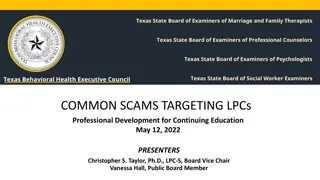Protect Yourself from Online Scams: Tips and Examples
Learn about scams, identity theft, and phishing schemes, along with ways to safeguard your personal and financial information online. Discover common tricks used by scammers and how to spot and avoid falling victim to online fraud. Explore examples of phishing emails and strategies to protect yourself from cyber threats.
Download Presentation

Please find below an Image/Link to download the presentation.
The content on the website is provided AS IS for your information and personal use only. It may not be sold, licensed, or shared on other websites without obtaining consent from the author. Download presentation by click this link. If you encounter any issues during the download, it is possible that the publisher has removed the file from their server.
E N D
Presentation Transcript
SCAM SCAM-AN ATTEMPT TO TRICK SOMEONE, USUALLY WITH THE INTENTION OF STEALING MONEY OR PRIVATE INFORMATION. DO YOU KNOW SOMEONE WHO HAS BEEN SCAMMED? WHAT HAPPENED? WHAT IS THE PURPOSE OF A SCAM? WHAT TRICKS DO PEOPLE USE TO CARRY OUT A SCAM? CAN PEOPLE GET SCAMMED ON THE INTERNET? HOW?
IDENTITY THEFT IDENTITY THEFT- A TYPE OF CRIME IN WHICH YOUR PRIVATE INFORMATION IS STOLEN & USED FOR CRIMINAL ACTIVITY. WHAT KINDS OF PERSONAL INFORMATION WOULD THE IDENTITY THIEVES BE LOOKING FOR?
ANYONE IS VULNERABLE! VULNERABLE-WHEN PEOPLE SEND YOU PHONY EMAILS, POP-UP MESSAGES, SOCIAL MEDIA MESSAGES, TEXT, CALLS, OR LINKS TO FAKE WEBSITES IN ORDER TO HOOK YOU INTO GIVING OUT YOUR PERSONAL AND FINANCIAL INFORMATION. WHAT WOULD MAKE YOU VULNERABLE?
HOW TO CATCH A PHISH HOW DO YOU THINK IDENTITY THIEVES MIGHT TRY TO GET YOUR INFORMATION? PHISHING-THE ACTIVITY OF ILLEGALLY OBTAINING A PERSON S ONLINE FINANCIAL ACCOUNT INFORMATION BY PRETENDING TO BE A REAL COMPANY.
SPOTTING SCAMS & SCHEMES GROUPS OF 2 COMPLETE PHISHING EXAMPLES TOGETHER IN YOUR ON COMPARE WITH ANOTHER GROUP TO CHECK ANSWERS WE WILL DISCUSS AS A CLASS!
PROTECT YOURSELF FROM ONLINE SCAMS IF YOU THINK YOU HAVE ENCOUNTERED A PHISHING SCAM ONLINE FOLLOW THESE RULES: AVOID OPENING THE MESSAGE OR EMAIL IN THE FIRST PLACE DON T CLICK ON ANY LINKS OR DOWNLOAD ANY ATTACHMENTS. THEY MIGHTCONTAIN VIRUSES OR SPYWARE MARK AS JUNK MAIL OR SPAM FOR YOUR EMAIL PROVIDER, OR REPORTIT TO YOUR SOCIAL NETWORK SITE IF YOU ARE CONCERNED ABOUT AN ACCOUNT YOU HAVE WITH A COMPANY, CONTACT ITS CUSTOMER SERVICE BY PHONE. MAKE SURE YOU VERIFY THE COMPANY S CONTACT INFORMATION ELSEWHERE ONLINE FIRST.
PROTECT YOURSELF FROM ONLINE SCAMS LOOK AT THESE NEXT EXAMPLES.
PHISHING EMAIL: EXAMPLE #1
The website that the link leads to is a spoof; a fake website, not created by Amazon.com. PHISHING EMAIL: EXAMPLE #1 It goes to http://citdsl.fix.netvision.net.il/login.html, not Amazon.com! When you enter the information they ask for, you will simply be handing the thieves the keys to your bank accounts.
PHISHING EMAIL: EXAMPLE #2
The website that the link leads to is a spoof; a fake website, not created by AT&T Wireless. It goes to a variety of URLs, including http://lbn.emiks.pl/PGAfg3dF/index.html, not AmericanExpress.com! PHISHING EMAIL: EXAMPLE #2 When you enter the information they ask for, you will simply be handing the thieves the keys to your bank accounts.
WRAP-UP: WHAT KINDS OF INFORMATION DO IDENTITY THIEVES LOOK FOR? WHY? HOW DO THIEVES TRY TO GET AT YOUR INFORMATION? WHAT CAN YOU TO DO AVOID THE FALLING FOR ONLINE SCAMS?














![101 Reviews How to Recover Lost Bitcoin [Scammed/Stolen Funds]](/thumb/153354/101-reviews-how-to-recover-lost-bitcoin-scammed-stolen-funds.jpg)








